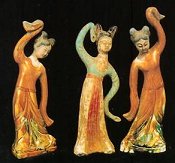|
Prohibited Sexual Behavior and Sexual Violence
|
|
Prostitution: Historical Note
|
|
|

|
|
Dancing Prostitutes
Chinese porcelain figures,
8th.- 9th centy AD.
(Courtesy China Sex Museum, Tongli)
|
|
Prostitution has often been called “the world’s oldest profession”, and indeed it has existed since time immemorial in all ancient and modern civilzations. In the ancient Near East, it even had a religious aspect when “sacred prostitutes” worked in the service of a fertility goddess and their earnings went to the temple. However, we know from the Bible that this ritualistic “temple prostitution” was vehemently condemned by the Israelites. Nevertheless, in its profane form, prostitution flourished throughout the ancient world. Thus, when archeologists excavated the Roman city of Pompeii (destroyed in 79 A.D.) they were not surprised to find several brothels, one of them with the inscription “Hic habitat felicitas” (Here dwells happiness). In medieval Christian Europe, prostitution was officially tolerated according to the view of St. Thomas Aquinas that abolishing it would create disorder in the community and that “even a palace needs sewers”. In imperial China, prostitution was, for centuries, regulated by the government, but eventually became an ever-expanding private enterprise. With the founding of the People’s Republic in 1949, however, prostitution became illegal. Actually, in the course of Chinese history, there had already been repeated attempts to eliminate prostitution, but they had all proved futile in the long run. This is also true of other countries. The USA, for example, closed its legal brothels after World War I, but succeeded only in creating new forms of prostitution, from “pick-up bars” and “massage parlors” to “streetwalkers”, “call girls” and “escort services”. In Europe, two opposite strategies are being pursued today: Arresting the customers of prostitutes (Sweden) or turning prostitution into a “regular job” with health insurance and pension plan (Netherlands). This latter approach seems to be gaining ground in most other European countries.
Since the history of prostitution can easily be researched elsewhere, this course will offer only a few brief notes about some of its aspects that are still relevant to the current situation. |